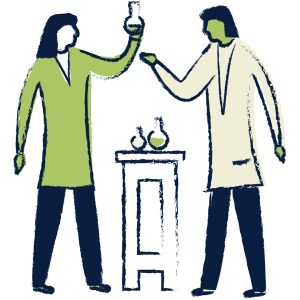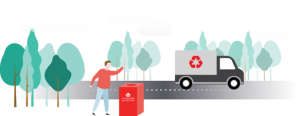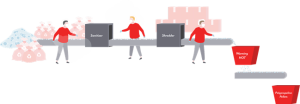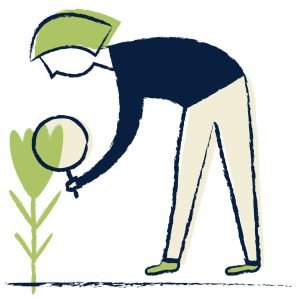Materials and energy reduction programs available to support green research and projects in UBCO laboratories and departments.
MATERIAL DIVERSION
Program News
UBC Okanagan’s laboratories provide experiential learning opportunities to students and are at the forefront of innovative discoveries by our researchers, they are also eager to reduce their waste related environmental impacts and accomplish this by participating in diversion programs offered by the UBCO Sustainability Office. Programs include the Lab Plastics Recycling Program (2010), Pipette Tip Box Recycling Program (2019) and the Pipette Tip & Tube along with the Personal Protective Equipment (PPE) recycling Programs introduced in 2023.
Since 2010, over 28 labs have participated in the Lab Plastic Recycling Program, successfully diverting 37,950 L or over 8 dumpsters of material from the landfill. The programs added in 2019 and 2023 were introduced to the campus labs to target hard-to-recycle plastics not accepted by municipal recycling facilities. To date, over 10 labs and 2 operational departments* participating in the Pipette Tip Box Recycling, Pipette Tip & Tube Recycling, and Personal Protective Equipment Recycling (PPE) Programs have diverted 303.1 kg of non-hazardous plastics from the landfill, reducing related emissions by 189.5 kgCO2e. This is equivalent to greenhouse gas emissions produced when driving a gasoline-powered vehicle over 782 kms or a round-trip from UBC Okanagan to UBC Vancouver.
These diversion programs support the UBCO Climate Action Plan 2030’s target of producing 50% less waste per capita, while progressing towards a zero-waste community, and successfully divert plastics from the landfill, where the risk of soil, water and air pollution increases, and the greenhouse gas methane (CH4) is created, which is twenty times worse than carbon dioxide (CO2).
Feedback from a UBCO Laboratory:
“In BRAES labs, we assist nearly 100 students across diverse research fields, resulting in a considerable volume of glove and plastic waste. For years, this waste has been directed to landfills. Embracing Lab Plastics Recycling Programs has successfully diverted this waste from landfills. The program’s streamlined approach simplifies waste separation, and the practical containers contribute to its seamless implementation, requiring no additional workload for the lab.”
Daniel Rosa, Ph.D.
Laboratory Technician V, Okanagan Institute for Biodiversity, Resilience, Ecosystem Services (BRAES)
Laboratory Technician V, Water Resource Science Laboratory
d.rosa@ubc.ca | https://braes.ok.ubc.ca/
*Following the successful PPE pilot conducted in 5 UBCO labs and the campus’ Security department, the program was expanded to include 3 new labs as well as UBCO Food Services, whose personnel utilize a high number of single-use gloves and masks each shift. Since expanding in August 2023, Food Services has diverted over 63kg of PPE, or over 14,000 gloves, from the landfill.
Personal Protective Equipment Recycling
Program Details
ACCEPTED MATERIAL
- non-contaminated gloves (nitrile, latex, vinyl)
- disposable masks & respirators
- hair & beard nets
- polypropylene isolation gowns
RECYCLING PROCESS
| Used PPE is deposited into designated Vitacore Recycling Bins then transported to the recycling facility. |  |
| PPE is sanitized at a high heat then sorted, shredded, and prepared for melting. The shredded and processed pieces are melted down and made into polypropylene pellets. |  |
| The polypropylene pellets are repurposed into construction material such as building materials, concrete reinforcement, and textiles. |  |
An illustration from Vitacore shows the process followed for the recycling program.
MEASURING THE IMPACTS
The material collected during the 2022 pilot diverted over 5,000 (37kg) of gloves and masks from the landfill. In 2023 an additional 12,675 pieces or 93.8kg of PPE was diverted by UBCO labs and Food Services. Check back regularly for progress reports on material collected from the program.
Impacts measured are projected to have a positive impact on waste diversion, greenhouse gas (GHG) reductions, and cost savings.
Pipette Tip & Tube Recycling
Thousands of pipette tips, microcentrifuge tubes and conical tubes are used in UBCO research and undergraduate laboratories each year. To date all materials have end up in either the landfill or at incineration centers. Following the successful 2023 pilot, which diverted over 40.62kg of non-biohazard/chemically contaminated tips and tubes from the landfill, a closed-loop recycling program, offered through Polycarbin, has been implemented.
Program Details
ACCEPTED MATERIAL
- non-biohazard or chemically contaminated
-
- pipette tips
- microcentrifuge tubes
- conical tubes
- others (TBD)
RECYCLING PROCESS
- Used tips/tubes are deposited into designated collection bins then transported to the recycling facility.
- Products are sanitized at a high heat then sorted, shredded, and prepared for melting. The shredded and processed pieces are melted down and made into pellets.
- The pellets are remanufactured into new lab products and avoid downcycling. Products are available for sale back to labs for another use.
MEASURING THE IMPACTS
The material collected during the 2023 pilot diverted over 40.62kg of material from the landfill. Check back regularly for progress reports on material collected from the program.
Impacts measured are projected to have a positive impact on waste diversion, greenhouse gas (GHG) reductions, and cost savings.
Pipette Tip Box Recycling
Thousands of pipette tip boxes are used in UBCO research and undergraduate laboratories each year. To date all materials have end up in the landfill as the plastics are found to be difficult to recycle. In 2019 research found a recycling program offered through Terracycle that accepted the pipette boxes and inserts, diverting this material from the landfill.
Program Details
ACCEPTED MATERIAL
- non-biohazard or chemically contaminated pipette tip boxes and inserts
RECYCLING PROCESS
- Used, empty pipette tip boxes and inserts are deposited into designated collection bins then transported to the recycling facility.
- Products are sanitized at a high heat then sorted, shredded, and prepared for melting. The shredded and processed pieces are melted down and made into pellets.
- The pellets are remanufactured into new products that include park benches and other useful products.
MEASURING THE IMPACTS
To date, the recycling program has diverted 131.66kg of material from the landfill. Check back regularly for progress reports on material collected from the program.
Impacts measured are projected to have a positive impact on waste diversion, greenhouse gas (GHG) reductions, and cost savings.
Other Lab Consumable Programs
Hazardous Materials Management
Health, Safety & Environment coordinates, manages and handles hazardous waste generated at UBCO by adhering to local, regional and federal regulations. The guides and procedures provided on the HSE’s website allow for both waste generators and the University as a whole to ensure compliance with regulations, UBC policies, and best management practices.

ENERGY REDUCTION
Shut the Sash
Fume hoods consume up to 20% of the Science building’s energy due to the large volume of air that needs to be heated or cooled and moved through them. Help save energy and Shut the Sash.
WHAT YOU CAN DO
Do you have a fume hood in your lab space? You can help your lab save energy by shutting the sash.
- Finished an experiment? Shut the Sash!
- Taking a break? Shut the Sash!
- Leaving for the day? Shut the Sash!
DID YOU KNOW THAT AN OPEN FUME HOOD USES AS MUCH ENERGY AS 3.5 HOMES!
Well, it’s not the fume hood itself, it’s the air being sucked through it.
For health and safety reasons, labs use 100 per cent outside air. That entire volume of air first has to be heated or cooled to make it a comfortable temperature before it is brought into the lab. A lot of electricity is also required to run large supply and exhaust fans that move the air through the building and through the fume hoods.
HOW DOES SHUTTING THE SASH SAVE ENERGY?
Fume hoods in newer or recently renovated labs generally have variable air volume (VAV) fume hoods. For these hoods, vented air volume is controlled by the sash height. This means the lower the sash, the lower the amount of conditioned air exhausted. This means that shutting the sash reduces the total amount of conditioned air for the building and fans don’t have to work as hard to move that air – both of these result in big energy savings.
FUME HOOD BEST PRACTICES
The sash is an important safety barrier between you and your work, so sashes should only be opened to set up or modify an experiment. When the sash is shut there is still air flow through the hood to remove fumes.
Never use a fume hood just for storing chemicals – they belong in a safety cabinet, which don’t use huge volumes of air.
If your group is no longer using a fume hood, consider having it locked and de-commissioned so air no longer flows through it. Email facilities.ok@ubc.ca to find out how.
Download campaign poster for printing.
Shut the Sash Challenge
The Shut the Sash Challenge is a six-week competition + spirit challenge that aims to encourage lab users to reduce energy through one simple action—closing laboratory fume hoods. This year, undergraduate labs in the Science Building will be taking part in the October – November 2023 event.